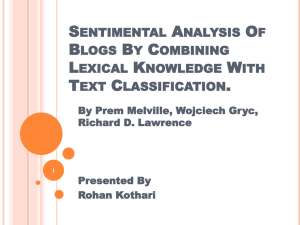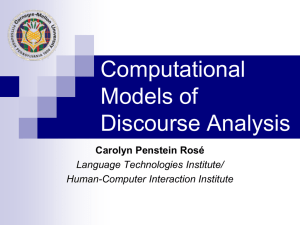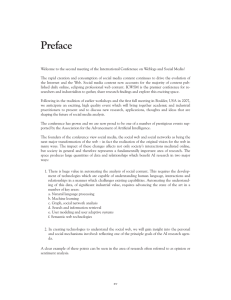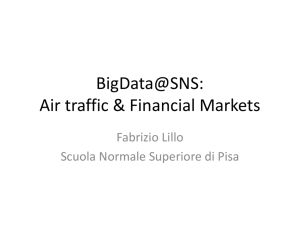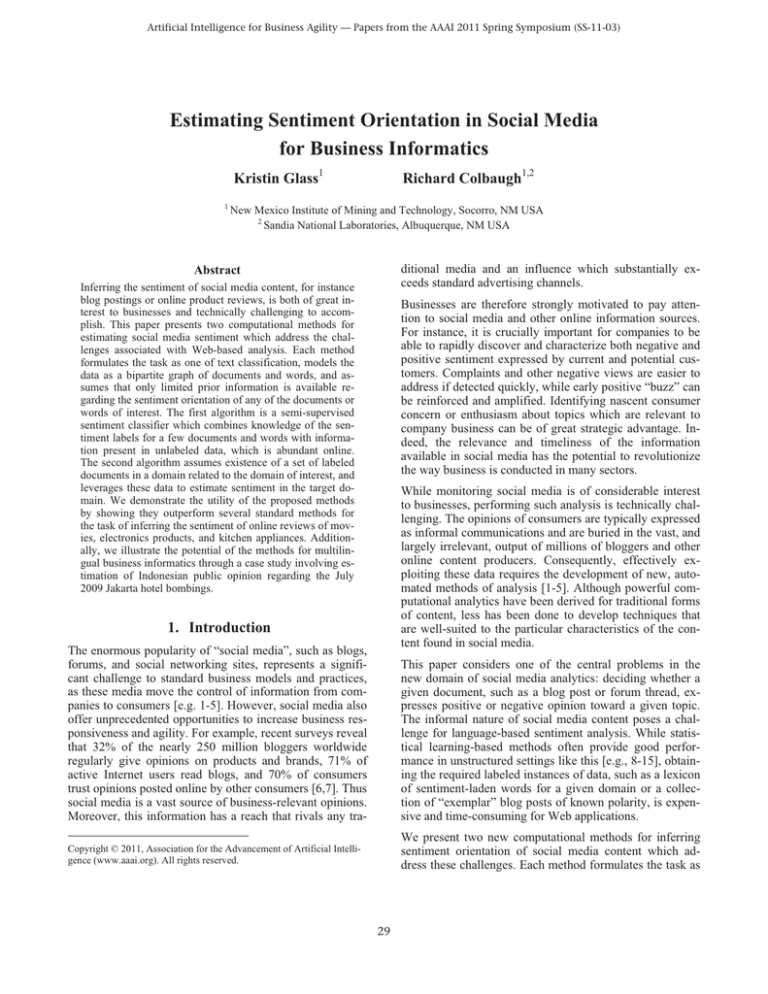
Artificial Intelligence for Business Agility — Papers from the AAAI 2011 Spring Symposium (SS-11-03)
Estimating Sentiment Orientation in Social Media
for Business Informatics
Kristin Glass1
1
Richard Colbaugh1,2
New Mexico Institute of Mining and Technology, Socorro, NM USA
2
Sandia National Laboratories, Albuquerque, NM USA
ditional media and an influence which substantially exceeds standard advertising channels.
Abstract
Inferring the sentiment of social media content, for instance
blog postings or online product reviews, is both of great interest to businesses and technically challenging to accomplish. This paper presents two computational methods for
estimating social media sentiment which address the challenges associated with Web-based analysis. Each method
formulates the task as one of text classification, models the
data as a bipartite graph of documents and words, and assumes that only limited prior information is available regarding the sentiment orientation of any of the documents or
words of interest. The first algorithm is a semi-supervised
sentiment classifier which combines knowledge of the sentiment labels for a few documents and words with information present in unlabeled data, which is abundant online.
The second algorithm assumes existence of a set of labeled
documents in a domain related to the domain of interest, and
leverages these data to estimate sentiment in the target domain. We demonstrate the utility of the proposed methods
by showing they outperform several standard methods for
the task of inferring the sentiment of online reviews of movies, electronics products, and kitchen appliances. Additionally, we illustrate the potential of the methods for multilingual business informatics through a case study involving estimation of Indonesian public opinion regarding the July
2009 Jakarta hotel bombings.
Businesses are therefore strongly motivated to pay attention to social media and other online information sources.
For instance, it is crucially important for companies to be
able to rapidly discover and characterize both negative and
positive sentiment expressed by current and potential customers. Complaints and other negative views are easier to
address if detected quickly, while early positive “buzz” can
be reinforced and amplified. Identifying nascent consumer
concern or enthusiasm about topics which are relevant to
company business can be of great strategic advantage. Indeed, the relevance and timeliness of the information
available in social media has the potential to revolutionize
the way business is conducted in many sectors.
While monitoring social media is of considerable interest
to businesses, performing such analysis is technically challenging. The opinions of consumers are typically expressed
as informal communications and are buried in the vast, and
largely irrelevant, output of millions of bloggers and other
online content producers. Consequently, effectively exploiting these data requires the development of new, automated methods of analysis [1-5]. Although powerful computational analytics have been derived for traditional forms
of content, less has been done to develop techniques that
are well-suited to the particular characteristics of the content found in social media.
1. Introduction
The enormous popularity of “social media”, such as blogs,
forums, and social networking sites, represents a significant challenge to standard business models and practices,
as these media move the control of information from companies to consumers [e.g. 1-5]. However, social media also
offer unprecedented opportunities to increase business responsiveness and agility. For example, recent surveys reveal
that 32% of the nearly 250 million bloggers worldwide
regularly give opinions on products and brands, 71% of
active Internet users read blogs, and 70% of consumers
trust opinions posted online by other consumers [6,7]. Thus
social media is a vast source of business-relevant opinions.
Moreover, this information has a reach that rivals any tra-
This paper considers one of the central problems in the
new domain of social media analytics: deciding whether a
given document, such as a blog post or forum thread, expresses positive or negative opinion toward a given topic.
The informal nature of social media content poses a challenge for language-based sentiment analysis. While statistical learning-based methods often provide good performance in unstructured settings like this [e.g., 8-15], obtaining the required labeled instances of data, such as a lexicon
of sentiment-laden words for a given domain or a collection of “exemplar” blog posts of known polarity, is expensive and time-consuming for Web applications.
We present two new computational methods for inferring
sentiment orientation of social media content which address these challenges. Each method formulates the task as
Copyright © 2011, Association for the Advancement of Artificial Intelligence (www.aaai.org). All rights reserved.
29
one of text classification, models the data as a bipartite
graph of documents and words, and assumes that only limited prior information is available regarding the sentiment orientation of any of the documents or words of interest. The first algorithm adopts a semi-supervised approach to sentiment classification, combining knowledge
of the sentiment polarity for a few documents and a small
lexicon of words with information present in a corpus of
unlabeled documents; note that such unlabeled data are
readily obtainable in online applications. The second algorithm assumes existence of a set of labeled documents in a
domain related to the domain of interest, and provides a
procedure for transferring the sentiment knowledge contained in these data to the target domain. We demonstrate
the utility of the proposed algorithms by showing they outperform several standard methods for the task of inferring
the sentiment polarity of online reviews of movies, electronics products, and kitchen appliances. Additionally, we
illustrate the potential of the methods for multilingual
business informatics through a case study involving estimation of Indonesian public opinion regarding the July
2009 Jakarta hotel bombings.
[XTX JI|V|] c
XT d,
(1)
where matrix Xnlu|V| has document vectors for rows,
dnl is the vector of document labels, I|V| denotes the
|V|u|V| identity matrix, and Jt0 is a constant; this corresponds to regularized least squares (RLS) learning [16].
Many other strategies can be used to compute c, including
Naïve Bayes (NB) statistical inference [8]. Learning-based
classifiers have the potential to improve their performance
and to adapt to new situations, but realizing these capabilities requires that fairly large training sets of labeled documents be obtained and this is usually an expensive undertaking.
Sentiment analysis of social media content for business
applications is often characterized by the existence of only
modest levels of prior knowledge regarding the domain of
interest, reflected in the availability of a few labeled documents and small lexicon of sentiment-laden words, and by
the need to rapidly learn and adapt to new domains. As a
consequence, standard knowledge-based and learningbased sentiment analysis methods are typically ill-suited
for business informatics. In order to address this challenge,
the sentiment analysis methods developed in this paper
enable limited labeled data to be combined with readily
available “auxiliary” information to produce accurate sentiment estimates. More specifically, the first proposed method is a semi-supervised algorithm [e.g., 11,12] which
leverages a source of supplementary data which is abundant online: unlabeled documents and words. Our second
algorithm is a novel transfer learning method [e.g., 13]
which permits the knowledge present in data that has been
previously labeled in a related domain (say movie reviews)
to be transferred to a new domain (electronics reviews).
2. Preliminaries
We approach the task of estimating the sentiment orientations of a collection of documents as a text classification
problem. Each document of interest is represented as a
“bag of words” feature vector x|V|, where the entries of
x are the frequencies with which the words in the vocabulary set V appear in the document (perhaps normalized in
some way [8]). We wish to learn a vector c|V| such that
the classifier orient
sign(cTx) accurately estimates the
sentiment orientation of document x, returning 1 (1) for
documents expressing positive (negative) sentiment about
the topic of interest.
Knowledge-based classifiers leverage prior domain information to construct the vector c. One way to obtain such a
classifier is to assemble lexicons of positive words VV
and negative words VV, and then to set ci 1 if word
iV, ci 1 if iV, and ci 0 if i is not in either lexicon;
this classifier simply sums the positive and negative sentiment words in the document and assigns document orientation accordingly. While this scheme can provide acceptable
performance in certain settings, it is unable to improve its
performance or adapt to new domains, and it is usually
labor-intensive to construct lexicons which are sufficiently
complete to enable useful sentiment classification performance to be achieved.
Figure 1. Cartoon of bipartite graph model Gb, in which documents (white vertices) are connected to the words (black vertices) they contain, and the link weights (black edges) reflect word
frequencies.
Alternatively, learning-based methods attempt to generate
the classifier vector c from examples of positive and negative sentiment. To obtain a learning-based classifier, one
can begin by assembling a set of nl labeled documents {(xi,
di)}, where di{1, 1} is the sentiment label for document i. The vector c then can be learned through “training”
with the set {(xi, di)}, for instance by solving the following
set of equations for c:
Each of the algorithms proposed in this paper assumes the
availability of a modest lexicon of sentiment-laden words.
This lexicon is encoded as a vector w|Vl|, where Vl
VV is the sentiment lexicon and the entries of w are set
to 1 or 1 according to the polarity of the corresponding
words. The development of the algorithms begins by mod-
documents
words
30
corresponding entry of c should be close to this r1 sentiment polarity; and 3.) if there is an edge Xij of Gb that connects a document x and a word vV and Xij possesses significant weight, then the estimated polarities of x and v
should be similar. These objectives are encoded in the following minimization problem:
eling the problem data as a bipartite graph Gb of documents
and words (see Figure 1). It is easy to see that the adjacency matrix A for graph Gb is given by
A
ª 0
«X T
¬
Xº
0 »¼
(2)
where the matrix Xnu|V| is constructed by stacking the
document vectors as rows, and each ‘0’ is a matrix of zeros. In both the semi-supervised and transfer learning algorithms, integration of labeled and “auxiliary” data is accomplished by exploiting the relationships between documents and words encoded in the bipartite graph model. The
basic idea is to assume that, in the bipartite graph Gb, positive/negative documents will tend to be connected to (contain) positive/negative words, and positive/negative words
will tend to be connected to positive/negative documents.
min
c aug
c Taug Lc aug
E1
Vl
nl
¦ (d
- di ) E2
2
est,i
i 1
¦ (c
i
- wi )2
i 1
(3)
where L D A is the graph Laplacian matrix for Gb, with
D the diagonal degree matrix for A (i.e., Dii 6j Aij), and
E1, E2 are nonnegative constants. Minimizing (3) enforces
the three properties we seek for caug, with the second and
third terms penalizing “errors” in the first two properties.
To see that the first term enforces the third property, observe that this expression is a sum of components of the
form Xij(dest,i cj)2. The constants E1, E2 can be used to
balance the relative importance of the three properties.
3. Semi-supervised Sentiment Analysis
We now derive our first sentiment estimation algorithm for
social media content. Consider the common situation in
which only limited prior knowledge is available about the
way sentiment is expressed in the domain of interest, in the
form of small sets of documents and words for which sentiment labels are known, but where abundant unlabeled
documents can be easily collected (e.g., via Web crawling).
In this setting it is natural to adopt a semi-supervised approach, in which labeled and unlabeled data are combined
and leveraged in the analysis process. In what follows we
present a novel bipartite graph-based approach to semisupervised sentiment analysis.
The caug which minimizes the objective function (3) can be
obtained by solving the following set of linear equations:
ªL 11 E 1 I nl
«
L 21
«
«
L 31
«
L 41
¬
L 12
L 22
L 32
L 42
L 33
L 13
L 23
E 2 I V1
L 43
L 14 º
L 24 »»
c aug
L 34 »
»
L 44 ¼
ª E 1d º
« 0 »
»
«
«E 2 w »
»
«
¬ 0 ¼
(4)
where the Lij are matrix blocks of L of appropriate dimension. The system (4) is sparse because the data matrix X is
sparse, and therefore large-scale problems can be solved
efficiently. Note that in situations where the set of available labeled documents and words is very limited, sentiment
classifier performance can be improved by replacing L in
(4) with the normalized Laplacian Ln D1/2LD1/2, or with a
power of this matrix Lnk (for k a positive integer).
Assume the initial problem data consists of a corpus of n
documents, of which nl n are labeled, and a modest lexicon Vl of sentiment-laden words, and suppose that this
label information is encoded as vectors dnl and w|Vl|,
respectively. Let destn be the vector of estimated sentiment orientations for the documents in the corpus, and
define the “augmented” classifier caug [destT cT]Tn|V|
which estimates the polarity of both documents and words.
Note that the quantity caug is introduced for notational convenience in the subsequent development and is not directly
employed for classification. More specifically, in the proposed methodology we learn caug, and therefore c, by solving an optimization problem involving the labeled and unlabeled training data, and then use c to estimate the sentiment of any new document of interest with the simple linear classifier orient sign(cTx). We refer to this classifier
as semi-supervised because it is learned using both labeled
and unlabeled data. Assume for ease of notation that the
documents and words are indexed so the first nl elements
of dest and |Vl| elements of c correspond to the labeled data.
We summarize this discussion by sketching an algorithm
for learning the proposed semi-supervised classifier:
Algorithm SS:
1. Construct the set of equations (4), possibly by replacing
the graph Laplacian L with Lnk.
2. Solve equations (4) for caug [ destT cT ]T (for instance
using the Conjugate Gradient method).
3. Estimate the sentiment orientation of any new document x of interest as: orient sign(cTx).
The utility of Algorithm SS is now examined through a
case study involving sentiment estimation for online movie
reviews, a task which is representative of many business
informatics applications.
We wish to learn an augmented classifier caug with the following three properties: 1.) if a document is labeled, then
the corresponding entry of dest should be close to this r1
label; 2.) if a word is in the sentiment lexicon, then the
31
gorithm SS outperforms the other three methods. Note that,
in particular, the accuracy obtained with the proposed approach is significantly better than the other techniques
when the number of labeled training documents is small. It
is expected that this property of Algorithm SS will be of
considerable value in business informatics applications that
involve social media data.
4. Case Study One: Movie Reviews
This case study examines the performance of Algorithm SS
for the problem of estimating sentiment of online movie
reviews. The data used in this study is a publicly available
set of 2000 movie reviews, 1000 positive and 1000 negative, collected from the Internet Movie Database and archived at the website [17]. The Lemur Toolkit [18] was employed to construct the data matrix X and vector of document labels d from these reviews. A lexicon of ~1400 domain-independent sentiment-laden words was obtained
from [19] and employed to build the lexicon vector w.
5. Transfer Learning Sentiment Analysis
This section develops the second proposed sentiment estimation algorithm for social media content. Many business
informatics applications are characterized by the presence
of limited labeled data for the domain of interest but ample
labeled information for a related domain. For instance, a
firm may wish to ascertain the sentiment of online discussions about its new line of kitchen appliances, and may
have in hand a large set of labeled examples of positive
and negative reviews for its electronics products (e.g., from
studies of previous product launches). In this setting it is
natural to adopt a transfer learning approach, in which
knowledge concerning the way sentiment is expressed in
one domain, the so-called source domain, is transferred to
permit sentiment estimation in a new target domain. In
what follows we present a new bipartite graph-based approach to transfer learning-based sentiment analysis.
This study compares the movie review orientation classification accuracy of Algorithm SS with that of three other
schemes: 1.) lexicon-only, in which the lexicon vector w is
used as the classifier as summarized in Section 2, 2.) a
classical NB classifier obtained from [20], and 3.) a welltuned version of the RLS classifier (1). Algorithm SS is
implemented with the following parameter values: E1
0.1, E2 0.5, and k 10. A focus of the investigation is
evaluating the extent to which good sentiment estimation
performance can be achieved even if only relatively few
labeled documents are available for training; thus we examine training sets which incorporate a range of numbers
of labeled documents: nl 50, 100, 150, 200, 300, 400,
600, 800, 1000.
Assume that the initial problem data consists of a corpus of
n = nT nS documents, where nT is the (small) number of
labeled documents available for the target domain of interest and nS !! nT is the number of labeled documents from
some related source domain; in addition, suppose that a
modest lexicon Vl of sentiment-laden words is known. Let
this label data be encoded as vectors dTnT, dSnS, and
w|Vl|, respectively. Denote by dT,estnT, dS,estnS, and
c|Vl| the vectors of estimated sentiment orientations for
the target and source documents and the words, and define
the augmented classifier as caug [dS,estT dT,estT cT]T
n|V|. Note that the quantity caug is introduced for notational convenience in the subsequent development and is
not directly employed for classification.
In what follows we derive an algorithm for learning caug,
and therefore c, by solving an optimization problem involving the labeled source and target training data, and
then use c to estimate the sentiment of any new document
of interest via the simple linear classifier orient sign(cTx).
This classifier is referred to as transfer learning-based
because c is learned, in part, by transferring knowledge
about the way sentiment is expressed from a domain which
is related to (but need not be identical to) the domain of
interest.
Figure 2. Results for the movie reviews case study. The plot
shows how sentiment estimation accuracy (vertical axis) varies
with number of available labeled movie reviews (horizontal
axis) for four different classifiers: lexicon only (LO), NB, RLS,
and Algorithm SS (SS).
Sample results from this study are depicted in Figure 2.
Each data point in the plots represents the average of ten
trials. In each trial, the movie reviews are randomly partitioned into 1000 training and 1000 test documents, and a
randomly selected subset of training documents of size nl is
“labeled” (i.e., the labels for these reviews are made available to the learning algorithm). As shown in Figure 2, Al-
We wish to learn an augmented classifier caug with the following four properties: 1.) if a source document is labeled,
then the corresponding entry of dS,est should be close to this
r1 label; 2.) if a target document is labeled, then the corresponding entry of dT,est should be close to this r1 label,
and the information encoded in dT should be emphasized
32
relative to that in the source labels dS,; 3.) if a word is in
the sentiment lexicon, then the corresponding entry of c
should be close to this r1 sentiment polarity; and 4.) if
there is an edge Xij of Gb that connects a document x and a
word vV and Xij possesses significant weight, then the
estimated polarities of x and v should be similar.
6. Case Study Two: Product Reviews
This case study examines the performance of Algorithm
TL for the problem of estimating sentiment of online product reviews. The data used in this study is a publicly available set of 1000 reviews of electronics products, 500 positive and 500 negative, and 1000 reviews of kitchen appliances, 500 positive and 500 negative, collected from
Amazon and archived at the website [21]. The Lemur
Toolkit [18] was employed to construct the data matrix X
and vectors of document labels dS and dT from these reviews. A lexicon of 150 domain-independent sentimentladen words was constructed manually and employed to
form the lexicon vector w.
The four objectives listed above may be realized by solving the following minimization problem:
min c Taug Lc aug E 1 d S, est - k S d S
c aug
E3 c - w
2
E 2 d T, est - k T d T
2
2
(5)
where L D A is the graph Laplacian matrix for Gb, as
before, and E1, E2, E3, kS, and kT are nonnegative constants.
Minimizing (5) enforces the four properties we seek for
caug. More specifically, the second, third, and fourth terms
penalize “errors” in the first three properties, and choosing
E2 ! E1 and kT ! kS favors target label data over source labels. To see that the first term enforces the fourth property,
note that this expression is a sum of components of the
form Xij (dT,est,i cj)2 and Xij (dS,est,i cj)2.The constants E1,
E2, E3 can be used to balance the relative importance of the
four properties.
This study compares the product review sentiment classification accuracy of Algorithm TL with that of four other
strategies: 1.) lexicon-only, in which the lexicon vector w
is used as the classifier as summarized in Section 2, 2.) a
classical NB classifier obtained from [20], 3.) a well-tuned
version of the RLS classifier (1), and 4.) Algorithm SS.
Algorithm SS is implemented with the following parameter
values: E1 1.0, E2 3.0, E3 5.0, kS 0.5, kT 1.0, and k
5. A focus of the investigation is evaluating the extent to
which the knowledge present in labeled reviews from a
related domain, here kitchen appliances, can be transferred
to a new domain for which only limited labeled data is
available, in this case electronics. Thus we assume that all
1000 labeled kitchen reviews are available to Algorithm
TL (the only algorithm which is designed to exploit this
information), and examine training sets which incorporate
a range of numbers of labeled documents from the electronics domain: nT 20, 50, 100, 200, 300, 400.
The caug which minimizes the objective function (5) can be
obtained by solving the following set of linear equations:
ªL 11 E 1 I nS
«
L 21
«
«
L 31
¬
L 12
L 13
L 22 E 2 I nT
L 23
L 32
L 33 E 3 I V1
º
»
» c aug
»
¼
ª E1k S d S º
«E k d »
« 2 T T»
«¬ E 3 w »¼
(6)
where the Lij are matrix blocks of L of appropriate dimension. The system (6) is sparse because the data matrix X is
sparse, and therefore large-scale problems can be solved
efficiently. In situations where the set of available labeled
documents and words is very limited, sentiment classifier
performance can be improved by replacing L in (6) with
the normalized Laplacian Ln or with a power of this matrix
Lnk.
We summarize the above discussion by sketching an algorithm for learning the proposed transfer learning classifier:
Algorithm TL:
1. Construct the set of equations (6), possibly by replacing
the graph Laplacian L with Lnk.
2. Solve equations (6) for caug [dS,estT dT,estT cT]T.
3. Estimate the sentiment orientation of any new document x of interest as: orient sign(cTx).
Figure 3. Results for the consumer product reviews case study.
The plot shows how sentiment estimation accuracy (vertical
axis) varies with number of available labeled electronics reviews (horizontal axis) for five different classifiers: lexicon
only (LO), NB, RLS, Algorithm SS (SS), and Algorithm TL
(TL).
The utility of Algorithm TL is now examined through a
case study involving sentiment estimation for online product reviews.
33
Sample results from this study are depicted in Figure 3.
Each data point in the plots represents the average of ten
trials. In each trial, the electronics reviews are randomly
partitioned into 500 training and 500 test documents, and a
randomly selected subset of reviews of size nT is extracted
from the 500 labeled training instances and made available
to the learning algorithms. As shown in Figure 3, Algorithm TL outperforms the other four methods. Note that, in
particular, the accuracy obtained with the transfer learning
approach is significantly better than the other techniques
when the number of labeled training documents in the target domain is small. It is expected that the ability of Algorithm TL to exploit knowledge from a related domain to
quickly learn an effective sentiment classifier for a new
domain will be of considerable value in business informatics applications involving social media data.
analysis revealed that the comments made directly to the
Top post are almost universally negative, condemning both
the bombings and the justification for the bombings given
in the Top post (see Figure 4). Manual examination of a
subset of the comments confirms the results provided by
Algorithm SS. Analysis of relevant posts made to other
blogs also indicated that sentiment about the Top post is
largely negative in these forums, although they are not as
uniformly negative as the comments made on the blog site
[22].
7. Case Study Three: Public Opinion
On 17 July 2009 the JW Marriott and Ritz-Carlton Hotels
in Jakarta, Indonesia were hit by suicide bombing attacks
within five minutes of each other. A little over a week later, on 26 July 2009, a document claiming responsibility for
the attacks and allegedly written by N.M. Top was posted
on the blog [22]; see Figure 4 for a screenshot of a portion
of this blog post. In subsequent discussions we will refer to
this post as the “Top post” for convenience, with the understanding that the authorship of the post is uncertain. At
the time, businesses in the travel and lodging sectors expressed interest in understanding sentiment in the region
regarding the bombings and the alleged claim of responsibility by a well-known extremist.
To enable a preliminary assessment along these lines, we
collected two sets of social media data related to the Top
post: 1.) ~3000 comments made to the post during the two
week period immediately following its publication, and 2.)
several hundred posts made to other Indonesian language
blogs in which the Top post was discussed. We manually
labeled the sentiment of a small subset of these documents,
and translated into Indonesian the generic sentiment lexicon used in Case Study One for implementation in this
study. Observe that this approach to constructing a sentiment lexicon is far from perfect. However, because our
proposed algorithms employ several sources of information
to estimate the sentiment of content, it is expected that they
will exhibit robustness to imperfections in any single data
source. This study therefore offers the opportunity to explore the utility of a very simple approach to multilingual
sentiment analysis: translate a small lexicon of sentimentladen words into the language of interest and then apply
Algorithm SS or Algorithm TL directly within that language (treating words as tokens). The capability to perform
automated, multilingual content analysis is of substantial
interest in modern business operations.
Figure 4. Results for public opinion case study. Image at
top is a screenshot of the blog post, allegedly by N.M. Top,
which claims responsibility for the July 2009 bombings of
two hotels in Jakarta, Indonesia. Plot at bottom shows the
estimated sentiment of comments made directly to the blog
[22] in response to the Top post (dark grey is negative,
light grey is “nonnegative”, including positive posts, with
light grey multiplied by a factor of 10 to be visible on the
plot).
Acknowledgements
We used Algorithm SS to estimate the sentiment expressed
in the corpus of comments made to the Top post [22] and
in the set of related discussions posted at other blogs. This
This research was supported by the U.S. Department of
Defense and the Laboratory Directed Research and Development Program at Sandia National Laboratories.
34
11. Sindhwani, V. and P. Melville, “Document-word coregularization for semi-supervised sentiment analysis”,
Proc. 2008 IEEE International Conference on Data
Mining, Pisa, Italy, December 2008.
12. Colbaugh, R. and K. Glass, “Estimating sentiment
orientation in social media for intelligence monitoring
and analysis”, Proc. 2010 IEEE International Conference on Intelligence and Security Informatics, Vancouver, BC Canada, May 2010.
13. Pan, S. and Q. Yang, “A survey on transfer learning”,
IEEE Trans. Knowledge and Data Engineering, Vol.
22, pp. 1345-1359, 2010.
14. Blitzer, J., M. Dredze, and F. Perieia, “Biographies,
bollywood, boom-boxes, and blenders: Domain adaptation for sentiment classification”, Proc. 45th Annual
Meeting of the ACL, Prague, June 2007.
15. He, J., Y. Liu, and R. Lawrence, “Graph-based transfer
learning”, Proc. 18th ACM Conference on Information
and Knowledge Management, Hong Kong, November
2009.
16. Hastie, T., R. Tibshirani, and J. Friedman, The Elements of Statistical Learning, Second Edition, Springer,
New York, 2009.
17. http://www.cs.cornell.edu/People/pabo/movie-reviewdata/, accessed Dec. 2009.
18. http://www.lemurproject.org/, accessed Dec. 2009.
19. Ramakrishnan, G., A. Jadhav, A. Joshi, S. Chakrabarti,
and P. Bhattacharyya, “Question answering via Bayesian inference on lexical relations”, Proc. 41st Annual
Meeting of the ACL, 2003.
20. http://www.borgelt.net/bayes.html, accessed Dec. 2009.
21. http://www.cs.jhu.edu/~mdredze/, accessed Dec. 2010.
22. www.mediaislam-bushro.blogspot.com, accessed Dec.
2009.
References
1. Glance, N., M. Hurst, K. Nigam, M. Siegler, R. Stockton, and T. Tomokiyo, “Deriving marketing intelligence
from online discussion”, Proc. 11th ACM International
Conference on Knowledge Discovery and Data Mining,
Chicago, August 2005.
2. Ziegler, C. and M. Skubacz, “Towards automated reputation and brand monitoring on the Web”, Proc. IEEE/
ACM International Conference on Web Intelligence,
Hong Kong, December 2006.
3. Melville, P., V. Sindhwani, and R. Lawrence, “Social
media analytics: Channeling the power of the blogosphere for marketing insight”, Proc. Workshop on Information in Networks, New York, September 2009.
4. Kaplan, A. and M. Haenlein, “Users of the world, unite!
The challenges and opportunities of social media”,
Business Horizons, Vol. 53, pp. 59-68, 2010.
5. van der Lans, R., G. van Bruggen, J. Eliashberg, and B.
Wierenga, “A viral branching model for predicting the
spread of electronic word of mouth”, Marketing
Science, Vol. 29, pp. 348-365, 2010.
6. http://www.universalmccann.com, accessed July 2010.
7. http://www.nielson.com, accessed July 2010.
8. Pang, B. and L. Lee, “Opinion mining and sentiment
analysis”, Foundations and Trends in Information Retrieval, Vol. 2 , pp. 1-135, 2008.
9. Dhillon, I., “Co-clustering documents and words using
bipartite spectral graph partitioning”, Proc. ACM International Conference on Knowledge Discovery and Data Mining, San Francisco, August 2001.
10. Kim, S. and E. Hovy, “Determining the sentiment of
opinions”, Proc. International Conference on Computational Linguistics, 2004.
35

